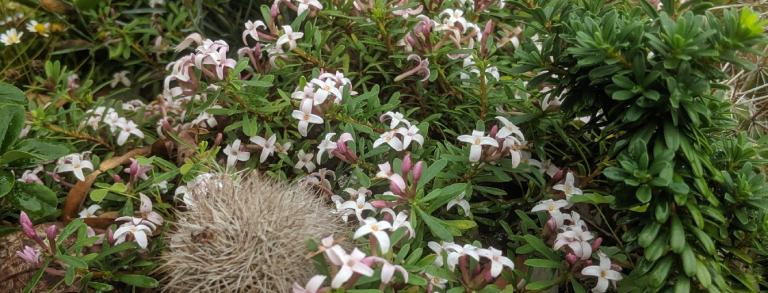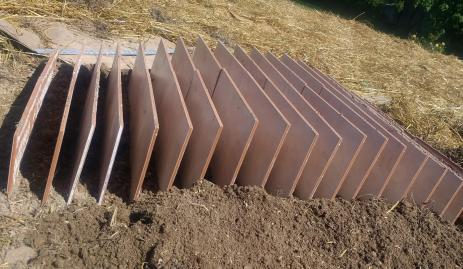TWO AND A half years ago, after a lifetime of gardening in the Great Lakes Region, I moved with my husband down to Williamsburg, Virginia. I went from Zone 5 to Zone 7, almost Zone 8. The average year down here has about three times as many days with highs over 90°F (32°C) as what I was used to in Michigan. My new home town gets an average of 47 inches (120 cm) of precipitation a year compared to the 36 inches (91 cm) I had known. In short, it is hot and wet down here, not exactly the preferred climate of many alpine plants.
I’m not used to the ground being covered with daffodils in February instead of snow, and I’m certainly not used to people using the word “blizzard” to describe a snowfall of four inches (10 cm). My whole gardening life I’ve made an annual routine of checking over the garden in the spring to see what survived the cold winter. Down here, winter doesn’t kill much. Instead, I’m checking to see what managed to avoid rotting during the hot, rainy summer.
My strategy to learn how to rock garden down here has been pretty straight forward. I built a simple crevice garden as a test plot, planted everything I could, and watched to see what died. There have been a lot of surprises, a lot of dead plants, and some successes.
My Crevice Garden
I chose to start with a crevice garden based on the reports, published here in the Quarterly, of the giant urbanite (recycled concrete) crevice gardens down at Plant Delights Nursery. Crevice gardens are not just beautiful and trendy, they seem to be one of the best ways to keep a wide range of finicky plants alive. The structure of a crevice gardens can be works of art on their own, but I didn’t have a lot of spare time or money, so I just built something basic. I’ll apply what I’ve learned in my crevice garden when I get around to building a big, beautiful version. Instead of stones, I bought a box of the cheapest one foot by one foot (30 x 30 cm) ceramic tiles I could find. I set the tiles vertically in the soil one to two inches (2.5 to 5 cm) apart. The tiles in the center I sank just a few inches into the soil. The outer tiles I buried deeper to make a mound-shaped crevice garden about ten inches (25 cm) tall in the middle and six inches (15 cm) tall at either end.
To fill, I bought a bag of coarse sand labeled “concrete sand” at the hardware store. I filled all the spaces between the tiles with sand, then topped the whole thing with a layer of gravel mulch. Plants have thrived in the nearly pure sand, quickly putting down deep roots to access additional moisture and fertility in the native soil below.
When planting, I bare-rooted everything before tucking it into a crevice. I didn’t wash the roots off, but I did break apart any circling roots and shake off the potting soil. I was worried that some plants, particularly the daphnes, would resent that much disturbance to their roots. I was more worried that the peat-based potting soil would hold too much moisture, leading to rot, and that roots would just stay circling in that rich, moist peat, rather than growing deep through the drier sand below.
What’s Still Alive
Just over two years in, I’m happy to say that a lot of plants are thriving, including several that I fully expected to die. Here are some of the survivors.
Daphnes
Alpine daphnes have been at once my biggest successes and disappointmentes. I planted Daphne ‘Kilmeston’, D. ‘Lawrence Crocker’, D. ‘Rosy Wave’ and D. x hendersonii expecting them to all die. ‘Lawrence Crocker’ bit the dust during the first summer, but the other three are thriving. That’s the good news. The bad news is that they just don’t flower like they did back north. In Michigan, D. x hendersonii was a solid mass of flowers every spring and rebloomed a couple of times during the summer and fall. Here, it is growing just fine, but the flower display is underwhelming. Alpine daphnes were my favorite rock garden plants in Michigan but I don’t think I’ll be planting them again down here. I’m holding out hope that the flower display will improve with age, but if it doesn’t, they may all get ripped out. The best performer, in terms of flowering, has been D. ‘Kilmeston’. It has never covered itself with blooms, but it does flower fairly heavily for a long stretch of spring and early summer.
Saponaria ‘Pink Surprise’
Right after I moved, I was in Minnesota to speak at a gardening event and got to visit with the legendary rock gardener and nursery woman Betty Ann Addison. She kept offering me plants and I kept saying they looked beautiful but I was sure they wouldn’t survive in my new, hot garden. Luckily, she didn’t listen to me, and I went home with some beauties, like Saponaria ‘Pink Surprise’. It is so tiny, so perfect and alpine-looking that I just knew it was going to die. I was completely wrong. It may be my favorite plant in the whole crevice garden, forming a perfect mound of tiny foliage and, in classic alpine fashion, completely covering itself with flowers in spring.
Dianthus ‘Red Penny’
This is another gift from Betty Ann Addison. Again, I looked at those silver leaves and the dense growth habit and thought there was no chance it would make it through a coastal Virginia summer. Again, I was completely wrong. It has produced masses of intense flowers in spring with sporadic rebloom through the summer. I bet it would rebloom even better if I deadheaded it.
Cactus
I’ve been collecting different species and hybrids of the genus Echinocereus for a few years. Many of them were perfectly hardy in my Michigan rock garden, they have beautiful flowers, and they don’t have obnoxious glochids like opuntias. Moving to a warmer climate, I happily put the whole collection into my crevice garden, where I’m sorry to say that some have died, and the others have merely survived. Echinocereus reichenbachii, E. milleri, and E. dasyacanthus have all survived and produce beautiful flowers, but they are basically the same size they were two years ago. I guess I shouldn’t be surprised that plants native to high dry places in the West don’t exactly love a constant deluge of water. I have seen happy specimens of other species around the Southeast, so maybe I just need to give them even better drainage. Or maybe I'm just being too impatient.
Aloe striatula (syn. Aloiampelos striatula)
I grew this from seed and plopped about 20 of them in my tiny crevice garden. The seedlings looked so small and innocent. By the end of their first summer, they were all over a foot (30 cm) tall and I was getting worried. I dug some out and gave them to friends but still had 15 going into their first winter. At first, I thought they’d all survive but mercifully a bit of colder weather killed all but three individuals. Those three may still be too large for the garden, but they are staying for now. They haven’t flowered yet, but the foliage is pretty fantastic.
Zinnia grandiflora
I’ve been a huge fan of this plant ever since seeing it growing in huge sheets in gardens in Denver. My experience is that there is a lot of variability in how well different clones perform in wet climates. My first plant was a named selection, ‘Gold on Blue’, which sat in my Michigan garden for one summer, never grew, and never flowered. Plants I grew from seed I purchased from Alplains showed huge variations in vigor. Some seedlings wasted away and died while others bloomed all summer long and spread vigorously. A couple of the happily growing seedlings moved down to Virginia with me where they are just as content. They pump out little yellow flowers all summer long, even through the most oppressive heat and humidity. I grow this in mounded sand next to the crevices because it can spread very aggressively. If you’d like to grow this plant in a rainy climate, I recommend starting with a packet of seed. The seed germinates easily, the seedlings start flowering their first summer, and you’ll get some genetic diversity to select from.
Zauschneria (Syn. Epilobium)
This is a genus I’ve drooled over on visits to Denver, where specimens cover themselves with a glorious excess of brilliant flowers. So I thought I’d try some. I purchased Z. latifolia ‘Woody’s Peach Surprise’, Z. garrettii ‘Orange Carpet’, and Z. canum var. arizonica ‘Sky Island Orange’. ‘Woody’s Peach Surprise’ bit the dust nearly immediately. But the other two didn’t just thrive, they quickly ran out of the crevice garden, into my heavy native soil, and started making pests of themselves. However, though they have proved to be something close to weeds, their first year I got a total of three miserable little flowers. Frustrated, I ripped all of them out of the crevice garden, but left some of the runners that had spread into the surrounding ground. This year it is a different story. I don’t know if it was the richer soil, a hot, dry spell at the end of the summer, or something else, but they bloomed like crazy, covering themselves with brilliant flowers. Hopefully, they’ll keep doing it in years to come.
Those are the highlights of my new crevice garden. I’ve killed a lot of plants and there remains a long list of plants to try in the future, but I’m thrilled with the range of rock garden plants I’ve been able to cultivate in my cheap little crevice garden in this sauna-like climate.


